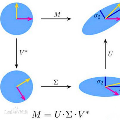To solve the problems of reduced accuracy and prolonging convergence time of through-the-wall radar (TWR) human motion due to wall attenuation, multipath effect, and system interference, we propose a multilink auto-encoding neural network (TWR-MCAE) data augmentation method. Specifically, the TWR-MCAE algorithm is jointly constructed by a singular value decomposition (SVD)-based data preprocessing module, an improved coordinate attention module, a compressed sensing learnable iterative shrinkage threshold reconstruction algorithm (LISTA) module, and an adaptive weight module. The data preprocessing module achieves wall clutter, human motion features, and noise subspaces separation. The improved coordinate attention module achieves clutter and noise suppression. The LISTA module achieves human motion feature enhancement. The adaptive weight module learns the weights and fuses the three subspaces. The TWR-MCAE can suppress the low-rank characteristics of wall clutter and enhance the sparsity characteristics in human motion at the same time. It can be linked before the classification step to improve the feature extraction capability without adding other prior knowledge or recollecting more data. Experiments show that the proposed algorithm gets a better peak signal-to-noise ratio (PSNR), which increases the recognition accuracy and speeds up the training process of the back-end classifiers.
翻译:为解决由于墙减速、多路效应和系统干扰而导致的穿墙雷达(TRW)人运动的精确度降低和缩短趋同时间的问题,我们建议采用多链接自动编码神经网络(TRW-MCAE)数据增强方法。具体地说,TRW-MCAE算法是由基于单值分解(SVD)的数据处理预处理模块、改进的协调关注模块、压缩感知可学习的迭代缩水阈值重建算法(LISTA)模块和适应性重量模块联合构建的。数据预处理模块可以实现墙结、人类运动特征和噪音子空间分离。改进协调关注模块可以实现断裂和噪音抑制。TAPA模块可以提高人的动作特征特征特性特征增强。适应性重力模块可以学习基于单值分解(SVD)的三个子空间的重量和连接。TRWR-MCAE可以同时抑制壁结的低级特征,并增强人类运动的紧张性能特性。在分类之前可以将数据分级步骤连接到提高地标提取速度能力,而无需事先将实验或重新显示其他数据升级的速度。




